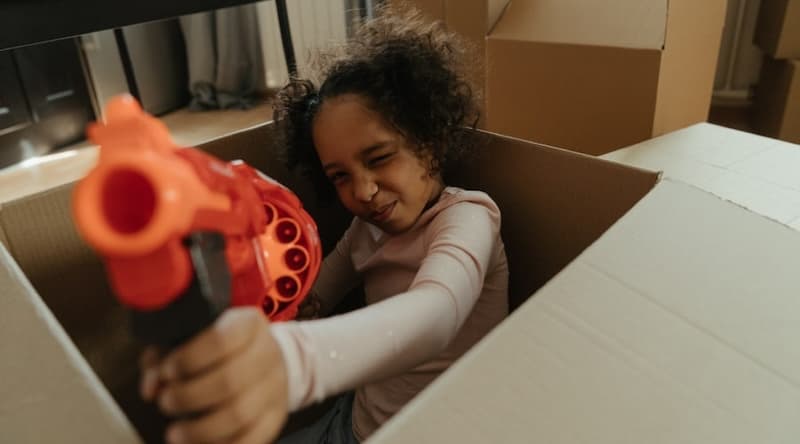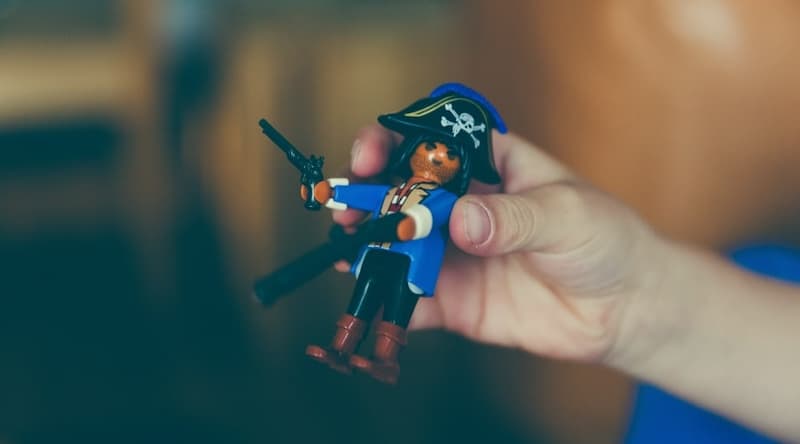settings
children
With Famly since
Imagine there’s a four-year old in front of you. They’re pointing a neon-orange water gun right at you, and they suddenly yell “Bang, bang!! You’re dead.”
Did that make you feel anxious? Is your gut telling you that there’s something wrong with that scene?
When it comes to toy weapons, a lot of us tend to think it’s ‘violent’ and goes against what we should be teaching children. What if it normalises violence, and children grow up to use real weapons? What if it makes them less sensitive?
It’s a big topic, but today we’re breaking it down bit by bit to really dig into why letting children play with toy weapons isn’t something we should be scared of.
If you’ve always allowed toy gun play or if it’s an absolute ‘no’ at your setting, this article might help put those worries or core beliefs into context, and reassure you that toy gun play isn’t all it’s made out to be.
I chatted to Jeffrey Goldstein, a professor and researcher in aggression and conflict at The University of Utrecht, and Michael Thompson, clinical psychologist and child development author to find out exactly why toy weapons are a normal and unconcerning part of child development.
It’s important to note that policies around owning real firearms differ around the world. This article is written from a European perspective, where owning real firearms is not usual. The discussion surrounding toy guns and toy weapons is therefore written with the idea that there’s little danger that fake weapons can be misinterpreted as real ones, or that they could put any lives at risk.
The big ideas

Do toy guns really make children aggressive?
This is one of the most important points to break down. To answer this, we’ve got to think about children’s intent: As Jeffrey Goldstein points out, there’s a big difference between playing, and intentionally harming someone.
“Children know that aggressive play is not the same as aggressive behaviour,” he says. “The key is in the intention of the child’s behaviour.”
Let’s take a look at what this difference might look like in your setting:
- A group of children are running and chasing each other with toy weapons. They’re laughing, smiling and communicating. Some may be in teams and this lasts for hours at a time. This is pretend aggression.
- Two children are in a corner with toy weapons, and one child is very unhappy. The unhappy child may get poked badly in the eye with a foam sword, or is hit with a meaningful and hard kick. The interaction is very quick, and the two children are not friends after the interaction is over. This is real aggression.
Jeffrey states that children have unspoken, mutually agreed rules before they start to engage in weapon and war-themed play. They know before they begin that they shouldn’t hurt one another, and that what they’re doing is completely make-believe.
“Unlike aggressive play, real aggression is over quickly, and does not usually involve smiling and laughter. Children who engage in play fighting remain friends afterwards, and are eager to repeat the experience,” he says.
But even just calling weapon and war play ‘aggressive’ isn’t ideal for some. Michael Thompson likes to stick to the terms ‘heroic play’ or ‘Good guys and bad guys,’ as he finds calling it ‘aggressive’ contributes to the belief that children are causing each other harm.
Top tip: Always look at children’s facial expressions and how they’re acting while they play. As a practitioner, you’ll be able to tell the difference between real and pretend aggression very quickly.
“Toy gun play turns children into violent adults”
Following on from this, we have to talk about the ‘link’ between aggressive play in children and violent behaviour in adulthood.
There isn’t one.
There has been study after study on why real aggression is a very different matter, and as both Jeffrey and Michael point out, aggressive play isn’t actually aggressive.
“If a child doesn’t hold their punches while the game is happening, they will be excluded from future play by the other children because they are showing real aggression,” says Jeffrey.
But instead of giving you lots of evidence that it doesn’t make violent adults, let’s take a closer look at some of the benefits of gun and weapon play. They’ll really help you understand why connecting violence and play doesn’t make sense, and that pretend aggression is a very natural phenomenon. In fact, it’ll show you why banning gun play actively disadvantages them by denying them creativity and imagination.
“Children wouldn’t play aggressively without toy guns."

Aggressive play isn't new
Aggressive play is a very normal part of development — in fact, humans are far from the only species who explore it.
“Aggressive play is part of early development - we see the same in young males in all primate species,” states Jeffrey. Even baby elephants engage in rough-and-tumble play with each other!
You’ll notice that Jeffrey highlighted that it’s usually boys who engage in this behaviour - and he’s right. Across a huge amount of studies and from what you’ve seen in your everyday practice, you’ve probably noticed that it’s usually boys who engage in this type of play.
But why? Academics across the board mention that this type of behaviour in young boys is something they’re born with. It isn’t learned behaviour, rather an innate drive. In short, it’s very normal for young boys to prefer rough-and-tumble and physical play.
Like with all forms of play, children incorporate aspects of the world they live in, says Jeffrey. It’s a way of helping them understand their surroundings. Maybe their favourite comic has characters with weapons, or they just see an image of it around town.
"Play is a way of imagining other lives, other scenarios and other people that you can pretend to be," states Jeffrey.
So, children do act out the things in the world around them - the fights they see on television and war play. But they’re acting on an impulse they were born with to make sense of these things. Not the other way around.
The benefits of aggressive play
Toy guns are a means for children to act out their play in a controlled and imaginative way - and it actually has a lot of benefits.
If a group of children are playing war with fake weapons in hand, this takes a lot of unseen skill. The children co-ordinate, they follow through on strategies, they get a sense of accomplishment, and they’re engaging mentally, socially and physically - just like sport. According to Jeffrey, it’s a whole package of child development.
“It involves playing roles, following rules and waiting their turn,” says Jeffrey. “It’s a physically active form of play that has all the benefits of sports.”
Michael takes a similar view, stating “Gun play allows children to experiment with power, to enact games and involve the mythic themes of good and evil.” Like all other forms of play, gun play is about imagination and creativity.
“These are imaginative games,” says Jeffrey. “They’re wrestling, playing superheroes and space invaders.” The theme is fighting, but they’re engaging their creativity in new and inventive ways.
In short: it encourages creativity, imagination, the exploration of world themes and helps them to develop - just like any good play should.
Emotional development
There’s a lot of concern that playing with toy guns will make children into less sensitive adults. But if we look at weapon play, it actually has a lot to do with regulating and connecting to emotions. It can be a way for boys to work through their emotions in a healthy, positive way.
Play fighting is an intimate form of play, as it includes:
- Physical contact
- Intense emotions
- Lots of noise
It lets them express and feel those intense emotions they may have sitting on their shoulders, and gives them an opportunity to work through them with their peers.
In terms of self-regulation, this is a fantastic tool. When children play fight, they’re controlling their anger, they’re actually holding back on aggressive behaviour and managing it so they don’t cause harm to any other child.
And this is particularly beneficial for young boys. We’ve come an incredibly long way in battling gender stereotypes, but some young boys are still told that they’re not allowed to show how they feel.
“You don’t see young boys holding hands down the street in the same way that young girls do,” states Jeffrey. So play fighting is actually an excellent way for them to work through emotions with their male peers. It gives them a sense of camaraderie and togetherness that young girls show in other, more obvious, ways.

Banning toy guns won't work
A zero tolerance approach very seldom works.
Jeffrey acknowledges that even if you take the toy weapons from children, they’ll just make them out of something else. A piece of toast becomes a sturdy shield, a carrot stick becomes a dagger and a stick turns into James Bond’s revolver.
Again, it’s not all about the weapon, as the aggressive behaviour is a natural part of their development. So why do we continue to try and ban it?
Michael sheds light on why we continue to try this tactic: “The reason parents and teachers create zero tolerance policies about gun play is that they think they’re encouraging violence prevention.”
But, he says, the scientific evidence on this matter speaks for itself - toy gun play doesn’t make children into violent adults.
Michael points out that it might be time to ask ourselves this question: why are we uncomfortable with toy gun and weapon play? If you’re only banning it because it makes you uncomfortable, then it’s time to take a little step back. We shouldn’t be punishing children for wanting to play because it makes us slightly uncomfortable - that isn’t putting the children’s wellbeing to forefront.
Top tips
We’ve got a few tips for you to keep in mind when observing and monitoring weapon play at your setting:
- Keep an eye out for children’s expressions and behaviour while they play. As a practitioner, you’ll know when children are playing or if you need to intervene because there’s real fighting or intentionally violent behaviour involved.
- There’s always some risk involved with aggressive play. Accidents do happen - but remember that you need to focus on the intent of the children. If they’re not intending to harm one another, then gun play is just another form of risky play.
- Pretend aggression and real aggression are two very different things. Professor Goldstein notes that there’s a huge leap between the two. So by allowing fighting games and war play, you’re not condoning real violence.
If you’re looking to read more about toy guns and giving weapon play a place at your setting, Penny Holland has an extremely comprehensive book on the subject.
Get 1000s of free EY activities
Want over 7,000 activities? See them in a free 14-day trial. Filter to target learning areas, age groups and topics, and get inspired.
Get started








